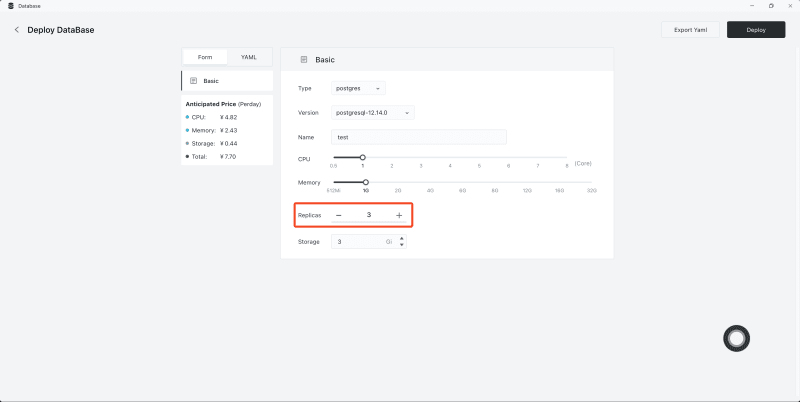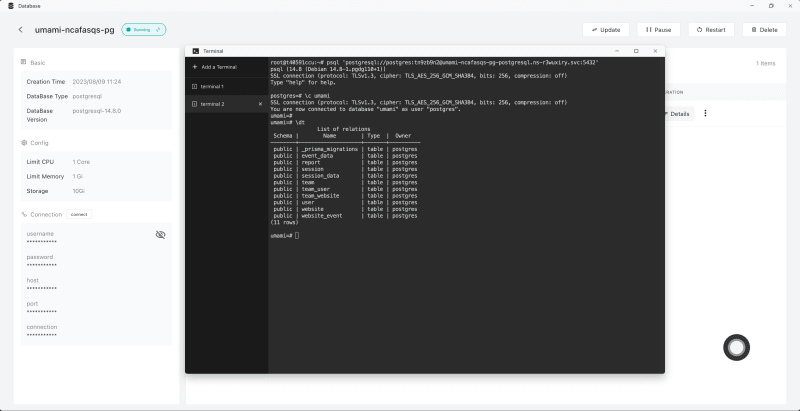Greetings to all readers! Today, we present an exquisite overview of the database services rendered by Sealos. KubeBlocks, an esteemed backend service provider, assures uninterrupted functioning of your database applications on Sealos. Regardless of employing it in a public domain or a local setup, Sealos deftly manages relational databases, NoSQL, vector databases, and streaming databases. This platform is tailored for professional environments, guaranteeing dependable, top-tier, transparent, and economically viable data infrastructure.
Let us embark on an exploration of the allure of database applications:
Feature Overview
Database Genesis
Sealos presents an intuitive database frontend platform, effectively obviating intricate command-line tasks. Via this platform, one can effortlessly instantiate diverse database categories, encompassing Mysql, PostgreSQL, MongoDB, Redis, and an expansive list beyond these.
Connection Dynamics
Upon entering the specifics page, one can scrutinize comprehensive database information and engage with it via a singular connection action. This streamlines procedures, augmenting your database interactivity quotient.
Assured Uptime Examination
Sealos shines in bestowing unparalleled uptime services, fortifying databases against untimely disruptions. This confers an augmented security layer to your repositories, facilitating a tranquil utilization. Our assertion of database resilience is corroborated with a succinct demonstration.
To commence, instantiate a database application with plural instances; in this case, a 3-instance PostGreSQL. Post-instantiation, one can interface with the database command terminal using the singular connection feature. We activate the Add a Terminal function to instantiate a secondary terminal module.
Subsequently, we identify test-postgresql-1 as the reigning master node. We then expeditiously remove this principal node employing the kubectl delete pod test-postgresql-1 command.
Restoration Capabilities
Our database also boasts a formidable backup and revival feature, assuring that even amidst data compromisation or loss, restoration to the backed-up state is effortless. Be it inadvertent deletions or calamitous events, these backups ensure rapid database reconstitution, curtailing operational stagnation.
For illustration, I have pre-curated data.
Navigate to the backup archive and activate the "Backup" button to commence the archival process. Herein, the manual archival method is showcased. Backup titles and annotations are modifiable; post modifications, one simply engages the "Start Backup" button.
Once the backup is completed, you can check the results through its status. You can click the "restore" icon to initiate the recovery process and wait for the restored database to successfully start.
Enter the restored database to view the data, and you will find the data successfully recovered.
Surveillance Capabilities
Within Sealos, beyond mere database management, you’re granted access to intuitive monitoring utilities. The operational status of your database is always at your fingertips, and its efficiency can be ascertained through graphical representations and metrics.
Functional Underpinnings
The prowess of KubeBlocks in proffering steadfast and adept database services on Sealos may pique your curiosity. Let's journey into its operational paradigms and fathom its resilient architecture and data recovery stratagems.
Design Paradigm for Stateful Services
KubeBlocks adeptly architects database topologies. With the Replicated State Machine (RSM) and its replication interrelations as its nucleus, it morphs intricate distributed databases into integrated foundational modules (blocks). Stateless, StatefulSet, or RSM, all seamlessly integrate within KubeBlocks. This facilitates the amalgamation of any database engine with KubeBlocks, birthing a dynamic system framework.
Resilient Architectural Blueprint
KubeBlocks inculcates dual resilience algorithms: consensus-driven and traditional primary-secondary. In consensus-driven databases, KubeBlocks oversees role discernment, rectification, and restructuring. The database autonomously manages thorough detection, adjudication, and transition tasks. For archetypal primary-secondary contexts, like MySQL and PostgreSQL pairings, KubeBlocks supervises detection, decision-making, transition, reconstruction, and role rectification. Moreover, its universal resilience blueprint accommodates myriad database categories such as replicated clusters and segmented clusters, amplifying reliability by enhancing replica counts and diminishing data loss chances.
Data Salvage Blueprint
To bolster data safety, KubeBlocks introduces a salvage and revival strategy. Backups cater to diverse scenarios such as data misplacement, calamity recovery, and data transference. On Sealos, a tangible backup feature is offered, signifying a direct replication of the database's corporeal files (both data and log) onto backup mediums like storage disks or tapes. These tangible backups are marked by swift restorations, consistent data, and storage optimization. Their efficiency in restoring backup files to the original database, preserving physical congruence with the database, and conserving storage space is unmatched. This makes it a premier choice for substantial databases, further elevating Sealos's prowess for professional settings.
For those captivated by database solutions, Sealos is a commendable platform to explore. Whether a developer, data maestro, or systems curator, this robust database service promises enhanced data management and operations. Let Sealos elevate your data endeavors to celestial heights!
Do not falter; experience it firsthand!
















Top comments (0)